A Spiny Climbing Robot with Dual-Rail Mechanism
Abstract
1. Introduction
2. Robot Design
2.1. Overall Design of Robot
2.2. Design of Spiny Track
2.3. Dual-Rail Mechanism
3. Modeling and Analysis
3.1. Attaching and Detaching Movements Analysis
3.2. Quasi-Static Force Analysis
3.3. Force Distribution Analysis
4. Results and Discussion
4.1. Force Distribution
4.2. Climbing Performance
4.3. Attachment and Detachment of Spiny Feet
5. Conclusions
Author Contributions
Funding
Institutional Review Board Statement
Informed Consent Statement
Data Availability Statement
Conflicts of Interest
References
- Fang, Y.; Wang, S.; Bi, Q.; Cui, D.; Yan, C.L. Design and technical development of wall-climbing robots: A review. J. Bionic Eng. 2022, 19, 877–901. [Google Scholar] [CrossRef]
- Zhu, H.F.; Guan, Y.S.; Wu, W.Q.; Zhang, L.M.; Zhou, X.F.; Zhang, H. Autonomous pose detection and alignment of suction modules of a biped wall-climbing robot. IEEE/ASME Trans. Mechatron. 2014, 20, 653–662. [Google Scholar] [CrossRef]
- Lee, G.; Kim, H.; Seo, K.; Kim, J.; Kim, H.S. MultiTrack: A multi-linked track robot with suction adhesion for climbing and transition. Robot. Auton. Syst. 2015, 72, 207–216. [Google Scholar] [CrossRef]
- Ge, D.X.; Tang, Y.C.; Ma, S.G.; Matsuno, T.; Ren, C. A pressing attachment approach for a wall-climbing robot utilizing passive suction cups. Robotics 2020, 9, 26. [Google Scholar] [CrossRef]
- Chen, X.L.; Wu, Y.P.; Hao, H.D.; Shi, H.L.; Huang, H.C. Tracked wall-climbing robot for calibration of large vertical metal tanks. Appl. Sci. 2019, 9, 2671. [Google Scholar] [CrossRef]
- Peidró, A.; Tavakoli, M.; Marín, J.M.; Reinoso, Ó. Design of compact switchable magnetic grippers for the HyReCRo structure-climbing robot. Mechatronics 2019, 59, 199–212. [Google Scholar] [CrossRef]
- Fan, J.Z.; Xu, T.; Fang, Q.Q.; Zhao, J.; Zhu, Y.H. A novel style design of a permanent-magnetic adsorption mechanism for a wall-climbing robot. J. Mech. Robot. 2020, 12, 035001. [Google Scholar] [CrossRef]
- Prahlad, H.; Pelrine, R.; Stanford, S.; Marlow, J.; Kornbluh, R. Electroadhesive robots-wall climbing robots enabled by a novel, robust, and electrically controllable adhesion technology. In Proceedings of the IEEE International Conference on Robotics and Automation, Pasadena, CA, USA, 19–23 May 2008; pp. 3028–3033. [Google Scholar]
- Koh, K.H.; Sreekumar, M.; Ponnambalam, S.G. Hybrid electrostatic and elastomer adhesion mechanism for wall climbing robot. Mechatronics 2016, 35, 122–135. [Google Scholar] [CrossRef]
- Gu, G.Y.; Zou, J.; Zhao, R.K.; Zhao, X.H.; Zhu, X.Y. Soft wall-climbing robots. Sci. Robot. 2018, 3, eaat2874. [Google Scholar] [CrossRef]
- Guo, J.L.; Leng, J.S.; Rossiter, J. Electroadhesion technologies for robotics: A comprehensive review. IEEE Trans. Robot. 2019, 36, 313–327. [Google Scholar] [CrossRef]
- Unver, O.; Sitti, M. Tankbot: A palm-size, tank-like climbing robot using soft elastomer adhesive treads. Int. J. Robot. Res. 2010, 29, 1761–1777. [Google Scholar] [CrossRef]
- Demirjian, W.; Powelson, M.; Canfield, S. Design of track-type climbing robots using dry adhesives and compliant suspension for scalable payloads. J. Mech. Robot. 2020, 12, 031017. [Google Scholar] [CrossRef]
- Shao, D.H.; Wang, Z.Y.; Ji, A.H.; Dai, Z.D.; Manoonpong, P. A gecko-inspired robot with cpg-based neural control for locomotion and body height adaptation. Bioinspir. Biomim. 2022, 17, 036008. [Google Scholar] [CrossRef] [PubMed]
- Yu, Z.W.; Shi, Y.; Xie, J.X.; Yang, S.X.; Dai, Z.D. Design and analysis of a bionic adhesive foot for gecko robot climbing the ceiling. Int. J. Robot. Autom. 2018, 33, 445–454. [Google Scholar] [CrossRef]
- Li, X.S.; Tao, D.S.; Lu, H.Y.; Bai, P.P.; Liu, Z.Y.; Ma, L.R.; Meng, Y.G.; Tian, Y. Recent developments in gecko-inspired dry adhesive surfaces from fabrication to application. Surf. Topogr. Metrol. Prop. 2019, 7, 023001. [Google Scholar] [CrossRef]
- Asbeck, A.T.; Kim, S.; Cutkosky, M.R.; Provancher, W.R.; Lanzetta, M. Scaling hard vertical surfaces with compliant microspine arrays. Int. J. Robot. Res. 2006, 25, 1165–1179. [Google Scholar] [CrossRef]
- Ji, A.H.; Zhao, Z.H.; Manoonpong, P.; Wang, W.; Chen, G.M.; Dai, Z.D. A bio-inspired climbing robot with flexible pads and claws. J. Bionic Eng. 2018, 15, 368–378. [Google Scholar] [CrossRef]
- Bian, S.Y.; Wei, Y.L.; Xu, F.; Kong, D.Y. A Four-legged Wall-climbing Robot with Spines and Miniature Setae Array Inspired by Longicorn and Gecko. J. Bionic Eng. 2021, 18, 292–305. [Google Scholar] [CrossRef]
- Spenko, M.J.; Haynes, G.C.; Saunders, J.A.; Cutkosky, M.R.; Rizzi, A.A.; Full, R.J.; Koditschek, D.E. Biologically inspired climbing with a hexapedal robot. J. Field Robot. 2008, 25, 223–242. [Google Scholar] [CrossRef]
- Liu, Y.W.; Sun, S.M.; Wu, X.; Mei, T. A leg-wheel wall-climbing robot utilizing bio-inspired spine feet. In Proceedings of the IEEE International Conference on Robotics and Biomimetics, Shenzhen, China, 12–14 December 2013; pp. 1819–1824. [Google Scholar]
- Xu, F.Y.; Wang, B.; Shen, J.J.; Hu, J.L.; Jiang, G.P. Design and realization of the claw gripper system of a climbing robot. J. Intell. Robot. Syst. 2018, 89, 301–317. [Google Scholar] [CrossRef]
- Parness, A.; Frost, M.; Thatte, N.; King, J.P.; Witkoe, K.; Nevarez, M.; Garrett, M.; Aghazarian, H.; Kennedy, B. Gravity-independent rock-climbing robot and a sample acquisition tool with microspine grippers. J. Field Robot. 2013, 30, 897–915. [Google Scholar] [CrossRef]
- Liu, G.W.; Liu, Y.W.; Wang, X.J.; Wu, X.; Mei, T. Design and experiment of a bioinspired wall-climbing robot using spiny grippers. In Proceedings of the IEEE International Conference on Mechatronics and Automation, Harbin, China, 7–10 August 2016; pp. 665–670. [Google Scholar]
- Parness, A.; Abcouwer, N.; Fuller, C.; Wiltsie, N.; Nash, J.; Kennedy, B. Lemur 3: A limbed climbing robot for extreme terrain mobility in space. In Proceedings of the IEEE International Conference on Robotics and Automation, Singapore, 29 May–3 June 2017; pp. 5467–5473. [Google Scholar]
- Nagaoka, K.; Minote, H.; Maruya, K.; Shirai, Y.; Yoshida, K.; Hakamada, T.; Sawada, H.; Kubota, T. Passive spine gripper for free-climbing robot in extreme terrain. IEEE Robot. Autom. Lett. 2018, 3, 1765–1770. [Google Scholar] [CrossRef]
- Xie, C.; Wu, X.; Wang, X.J. A three-row opposed gripping mechanism with bioinspired spiny toes for wall-climbing robots. J. Bionic Eng. 2019, 16, 994–1006. [Google Scholar] [CrossRef]
- Han, Q.F.; Ji, A.H.; Jiang, N.; Hu, J.; Gorb, S.N. A climbing robot with paired claws inspired by gecko locomotion. Robotica 2022, 40, 3686–3698. [Google Scholar] [CrossRef]
- Liu, Y.W.; Sun, S.M.; Wu, X.; Mei, T. A wheeled wall-climbing robot with bio-inspired spine mechanisms. J. Bionic Eng. 2015, 12, 17–28. [Google Scholar] [CrossRef]
- Carpenter, K.; Wiltsie, N.; Parness, A. Rotary microspine rough surface mobility. IEEE/ASME Trans. Mechatron. 2015, 21, 2378–2390. [Google Scholar] [CrossRef]
- Liu, J.F.; Xu, L.S.; Xu, J.J.; Li, T.; Chen, S.Q.; Xu, H.; Chen, G.X.; Ceccarelli, M. Design, modeling and experimentation of a biomimetic wall-climbing robot for multiple surfaces. J. Bionic Eng. 2020, 17, 523–538. [Google Scholar] [CrossRef]
- Liu, Y.W.; Wang, L.M.; Niu, F.Z.; Li, P.Y.; Li, Y.; Mei, T. A track-type inverted climbing robot with bio-inspired spiny grippers. J. Bionic Eng. 2020, 17, 920–931. [Google Scholar] [CrossRef]
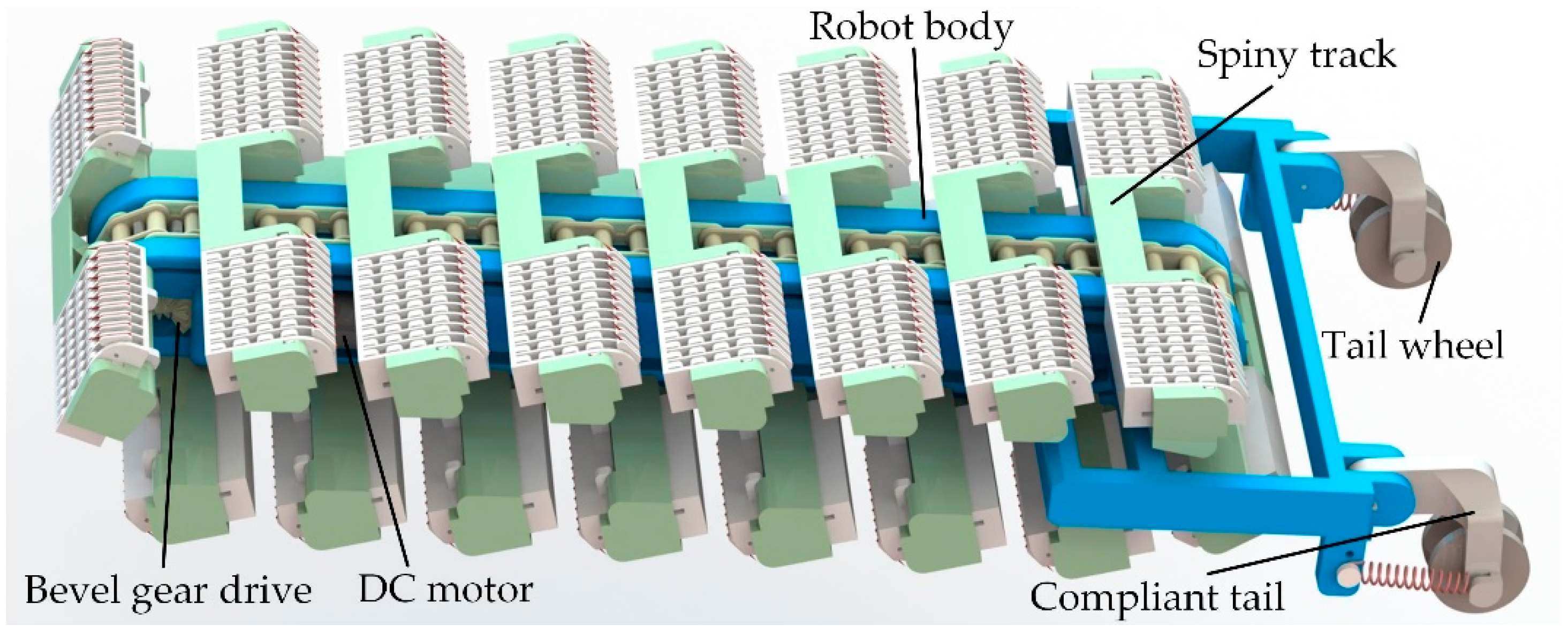




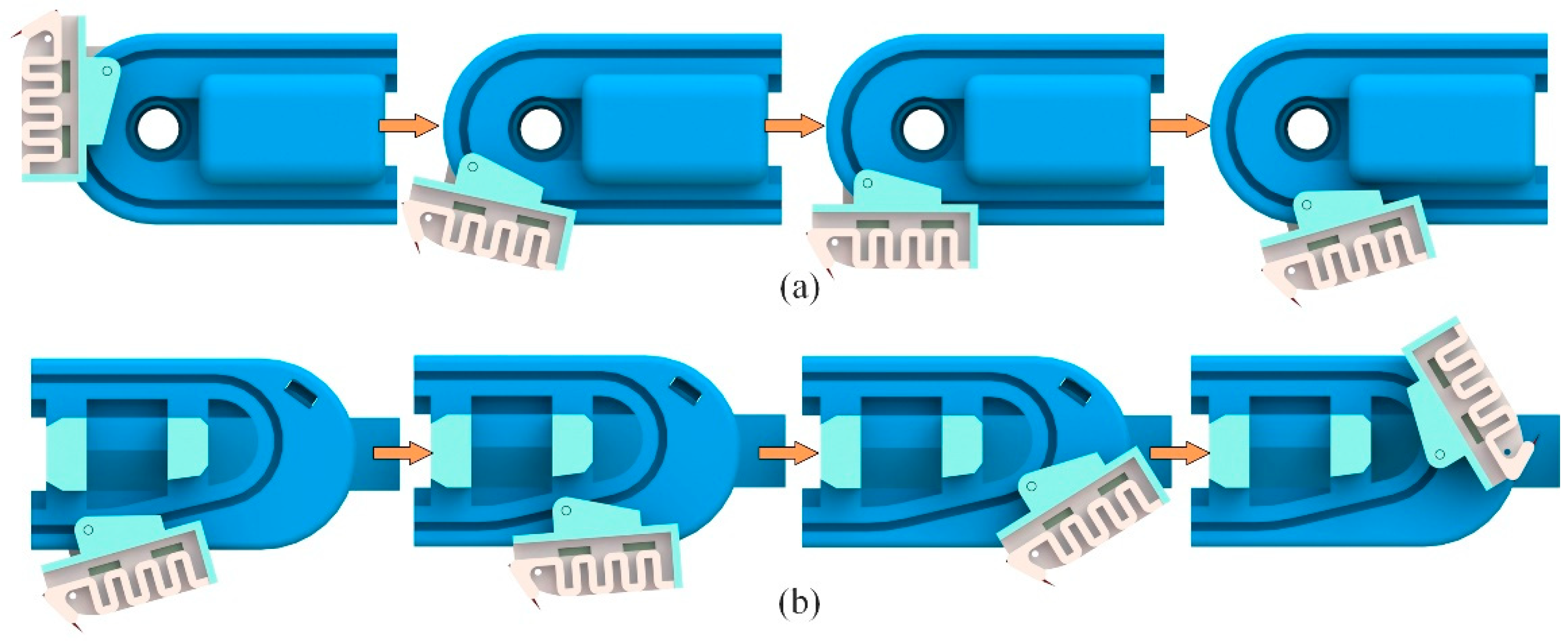
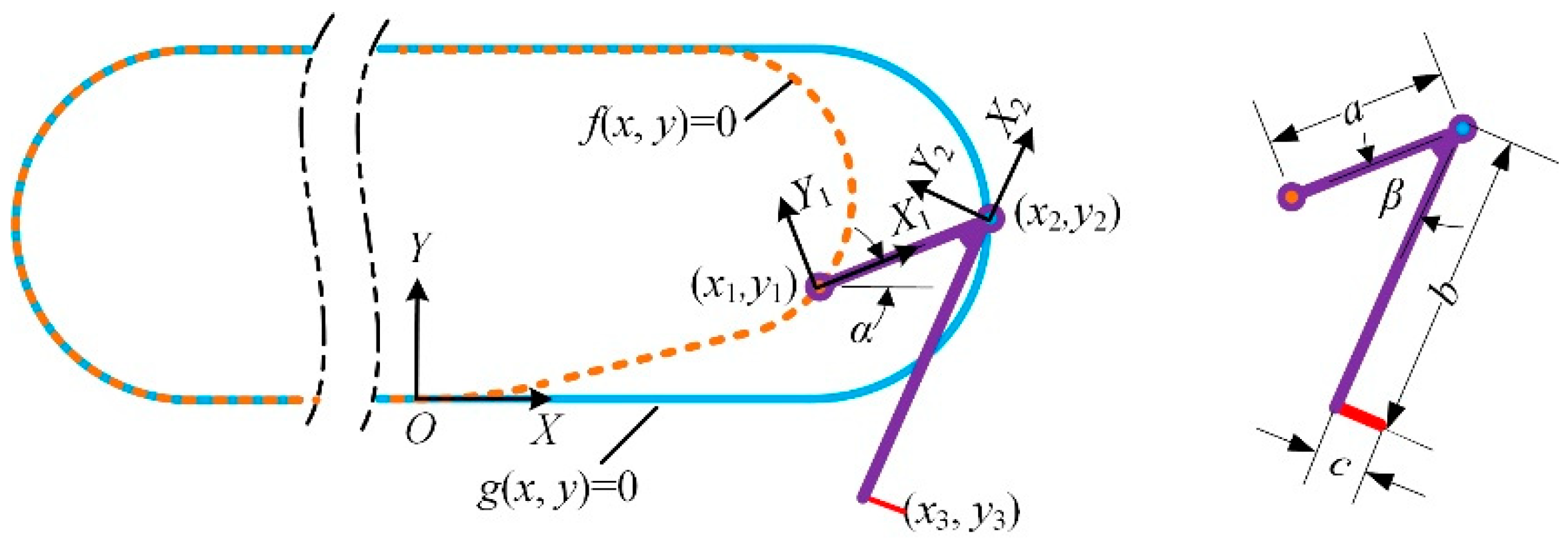
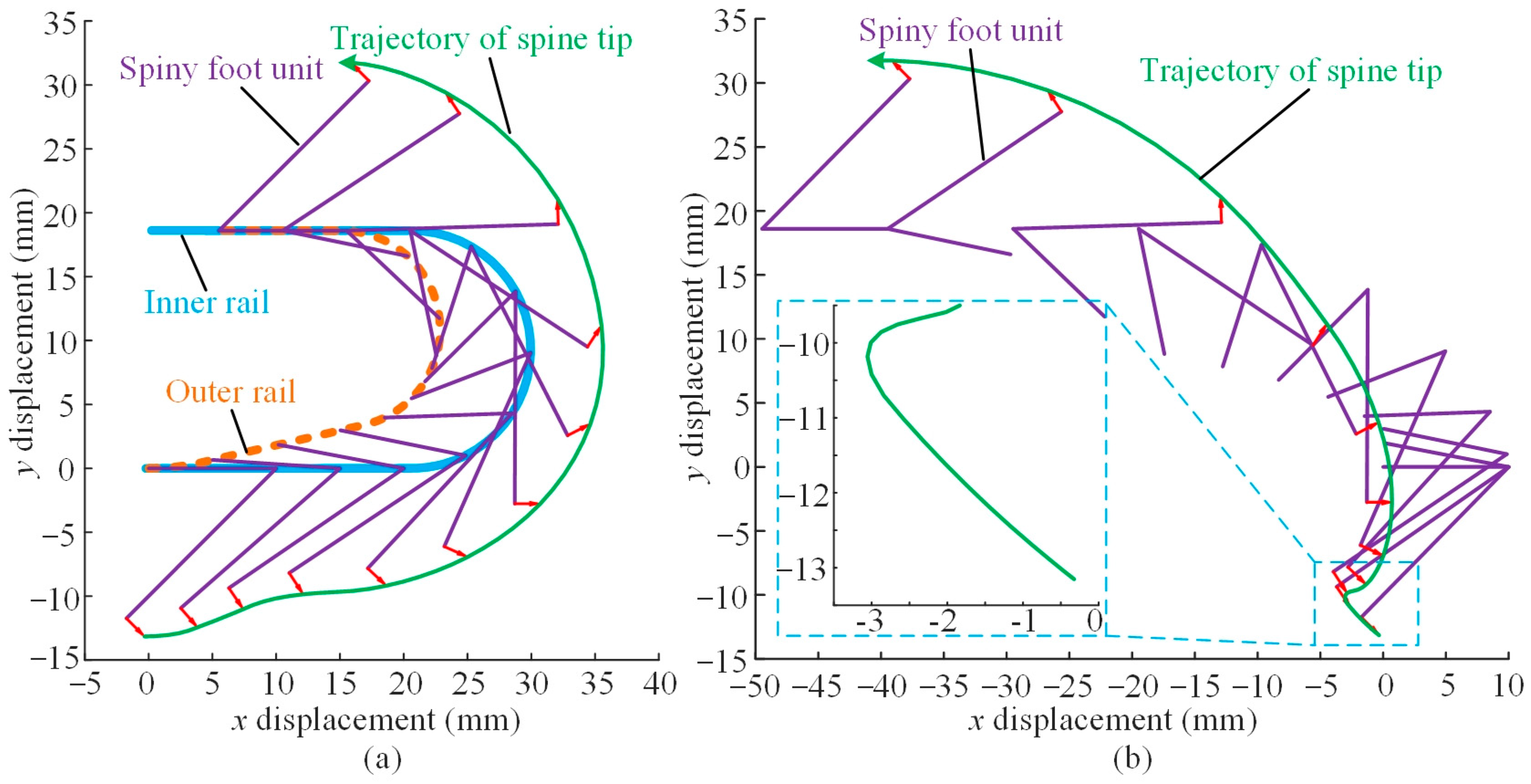
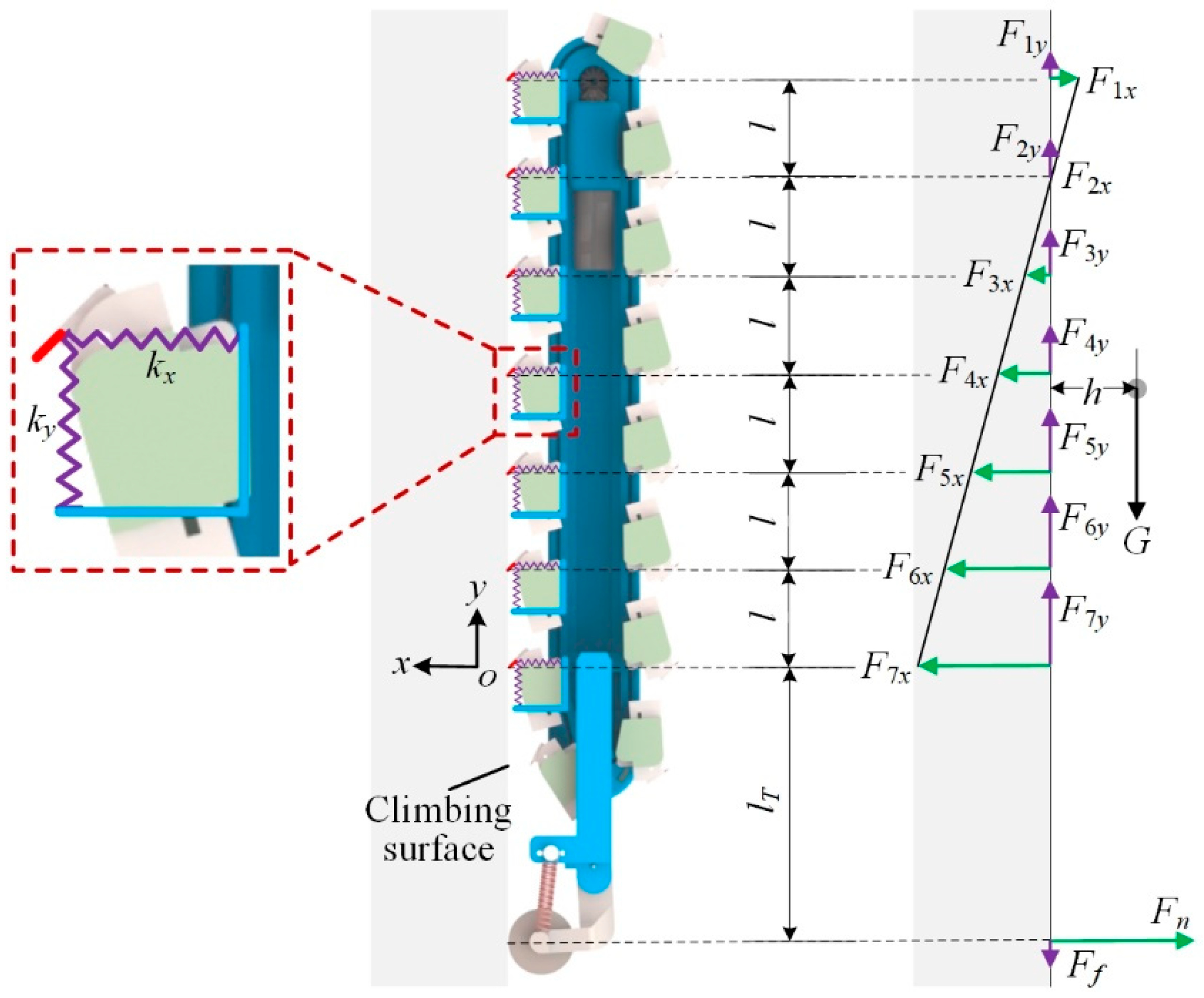
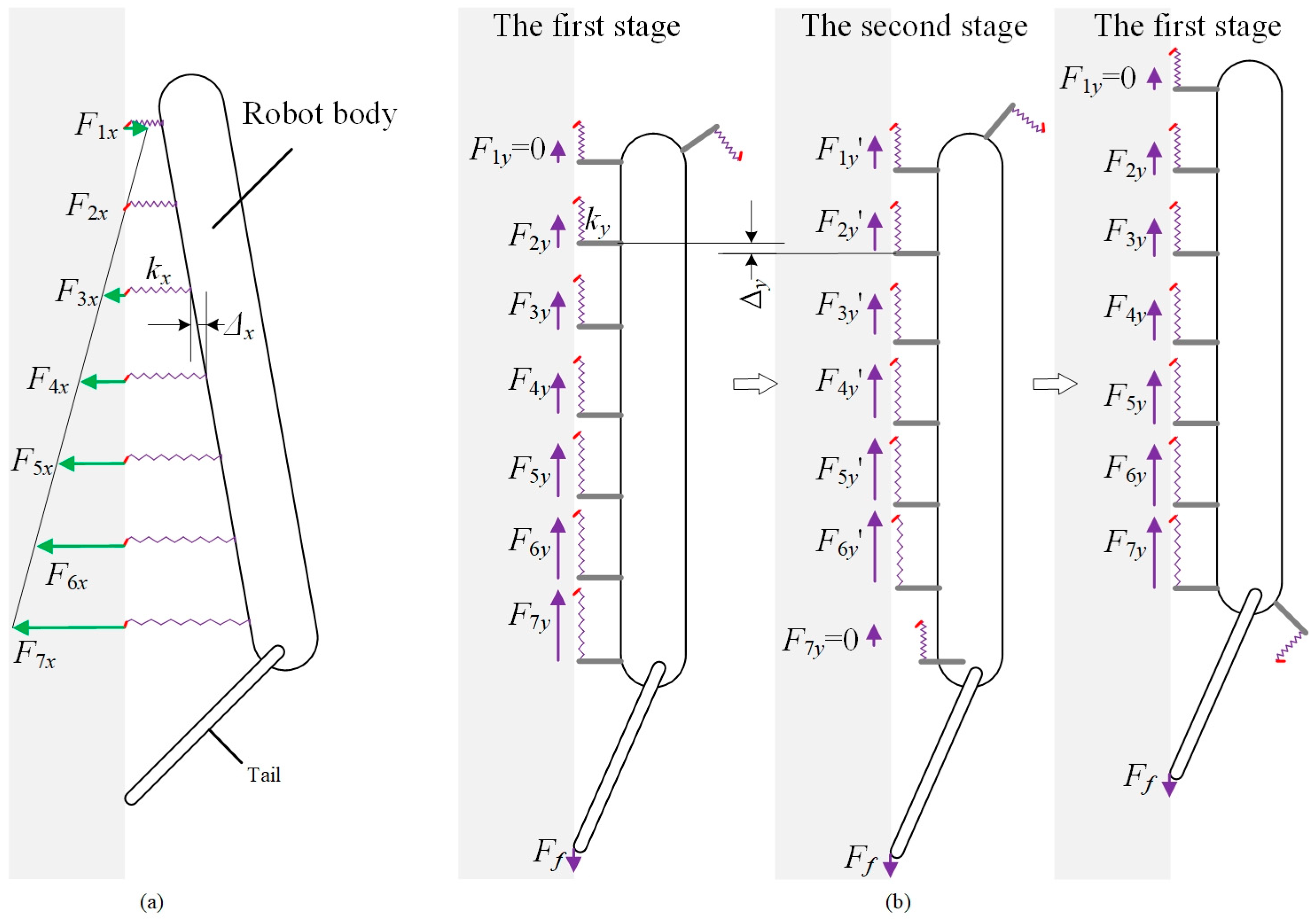
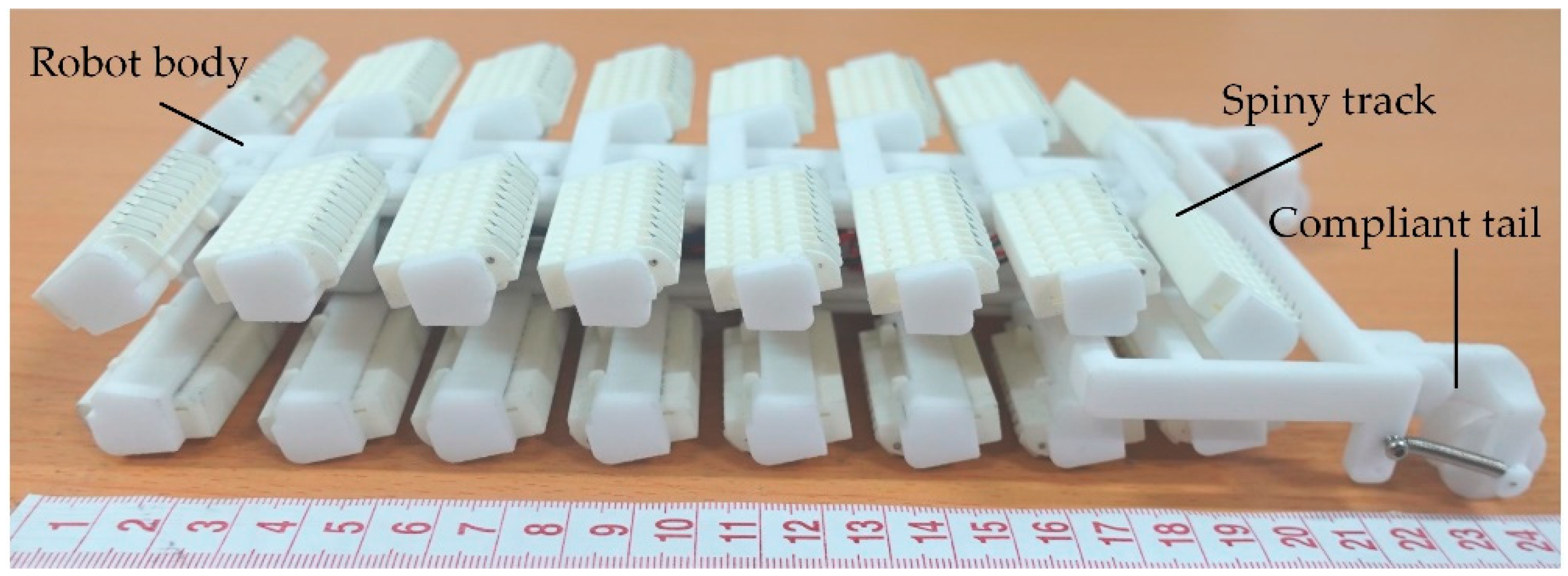


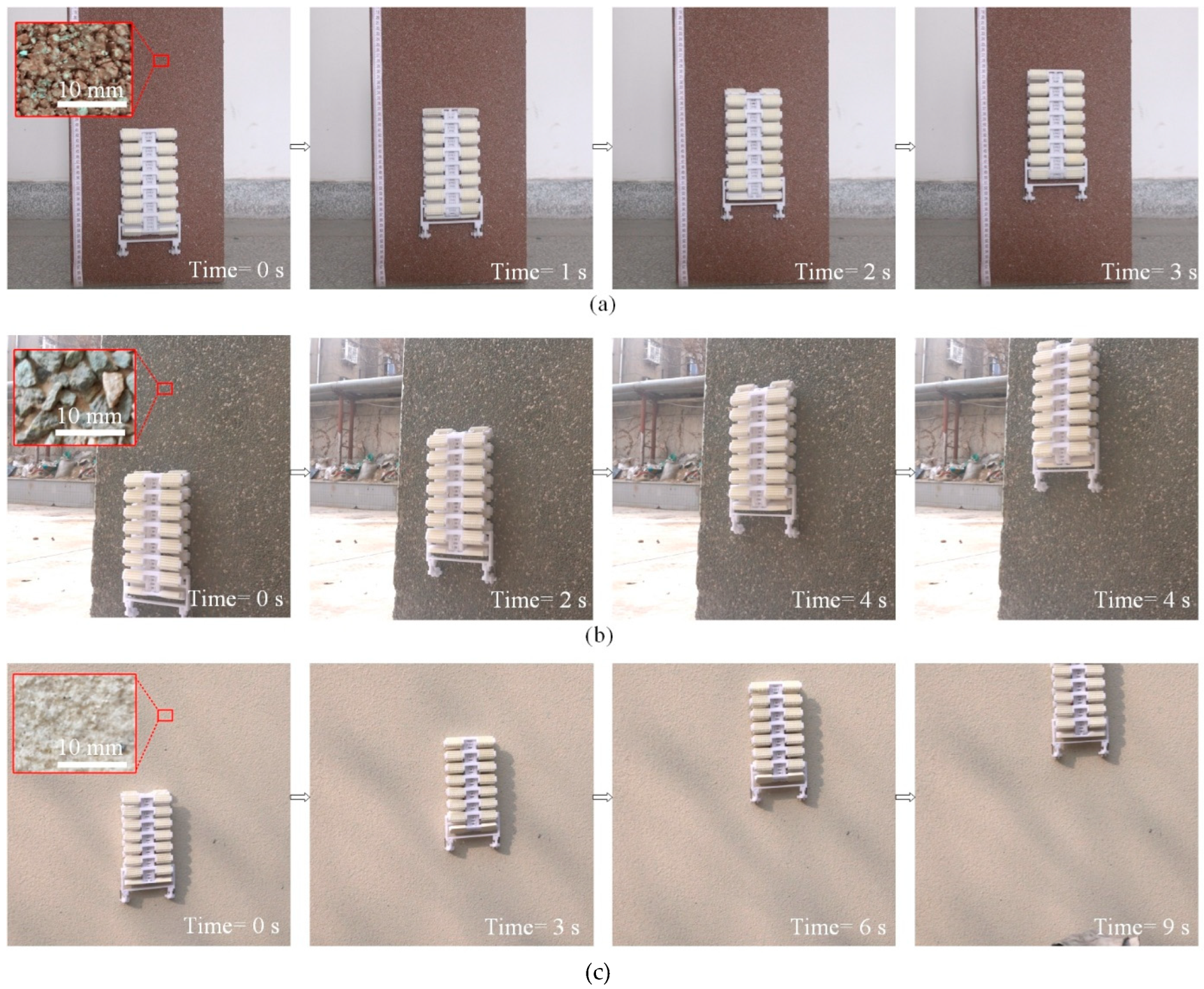
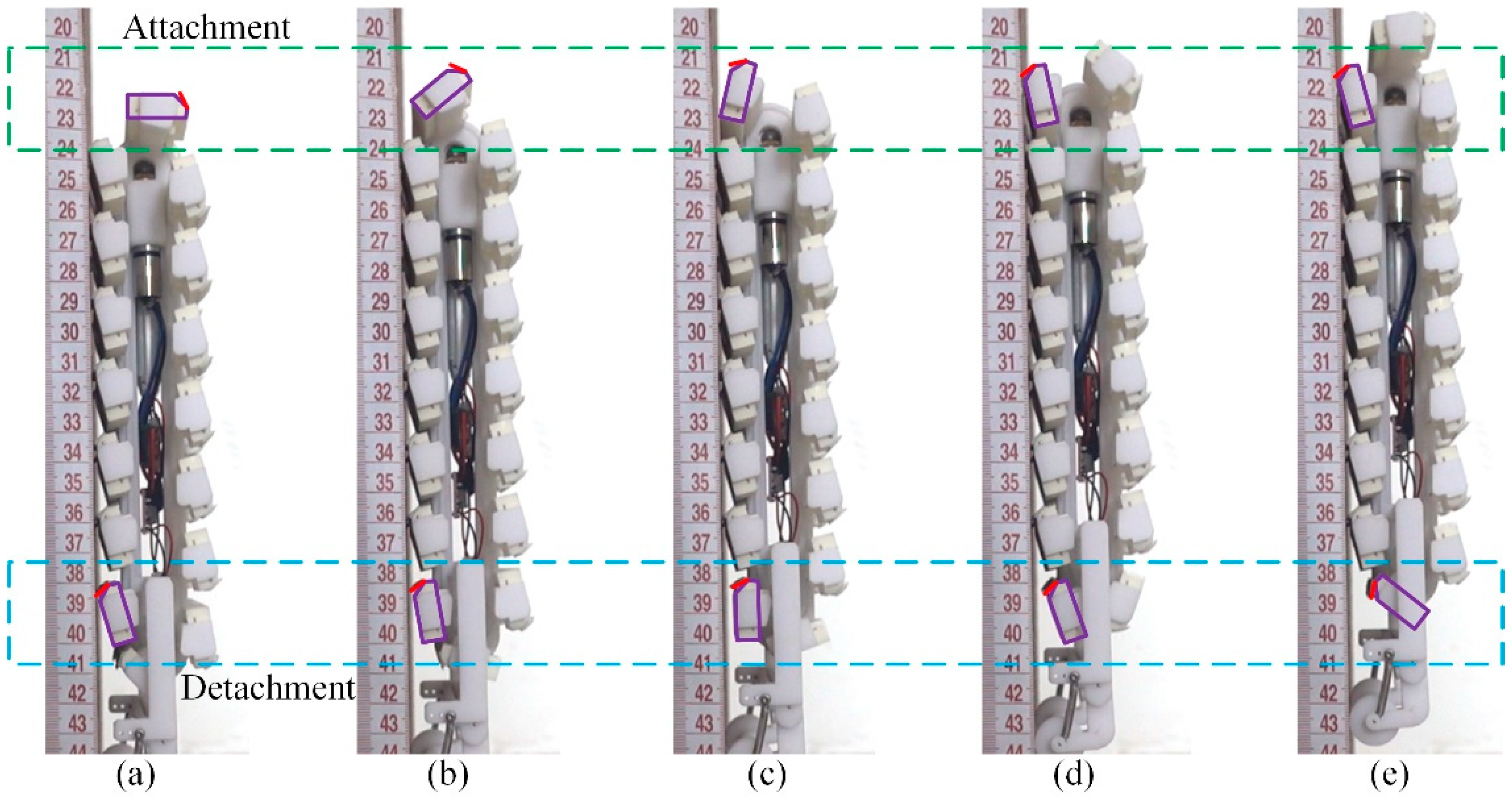
Disclaimer/Publisher’s Note: The statements, opinions and data contained in all publications are solely those of the individual author(s) and contributor(s) and not of MDPI and/or the editor(s). MDPI and/or the editor(s) disclaim responsibility for any injury to people or property resulting from any ideas, methods, instructions or products referred to in the content. |
© 2023 by the authors. Licensee MDPI, Basel, Switzerland. This article is an open access article distributed under the terms and conditions of the Creative Commons Attribution (CC BY) license (https://creativecommons.org/licenses/by/4.0/).
Share and Cite
Liu, Y.; Wang, H.; Hu, C.; Zhou, Q.; Li, P. A Spiny Climbing Robot with Dual-Rail Mechanism. Biomimetics 2023, 8, 14. https://doi.org/10.3390/biomimetics8010014
Liu Y, Wang H, Hu C, Zhou Q, Li P. A Spiny Climbing Robot with Dual-Rail Mechanism. Biomimetics. 2023; 8(1):14. https://doi.org/10.3390/biomimetics8010014
Chicago/Turabian StyleLiu, Yanwei, Hao Wang, Chongyang Hu, Qiang Zhou, and Pengyang Li. 2023. "A Spiny Climbing Robot with Dual-Rail Mechanism" Biomimetics 8, no. 1: 14. https://doi.org/10.3390/biomimetics8010014
APA StyleLiu, Y., Wang, H., Hu, C., Zhou, Q., & Li, P. (2023). A Spiny Climbing Robot with Dual-Rail Mechanism. Biomimetics, 8(1), 14. https://doi.org/10.3390/biomimetics8010014








